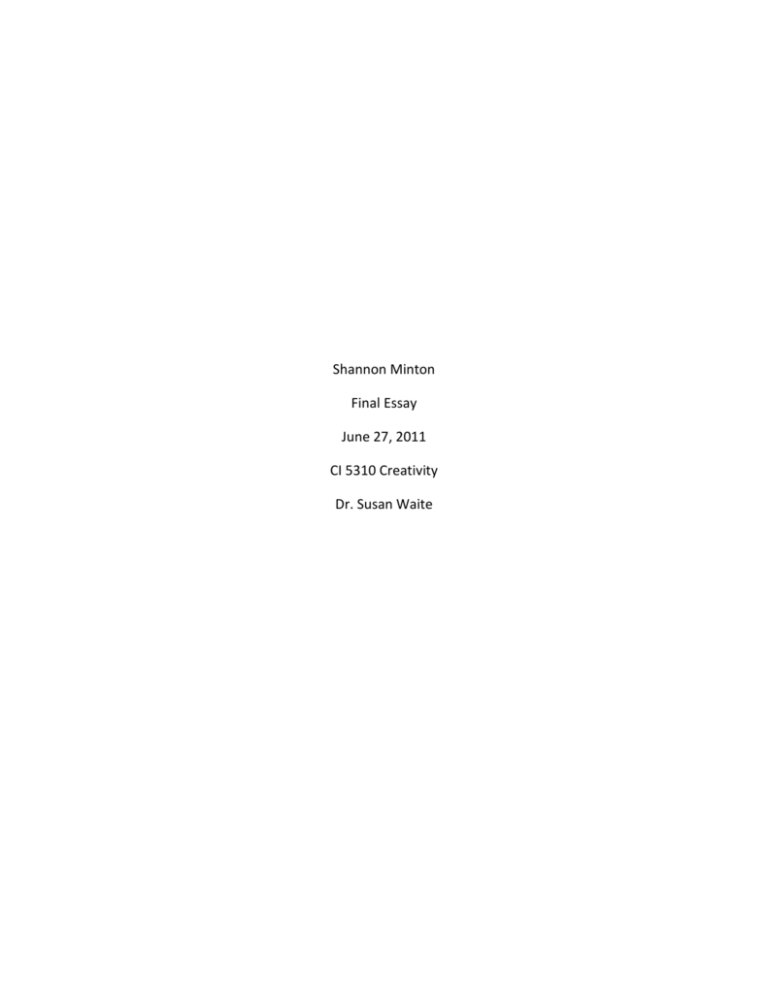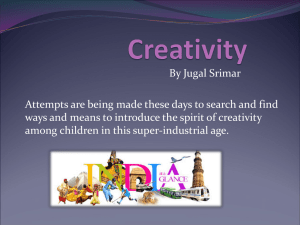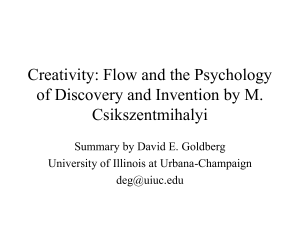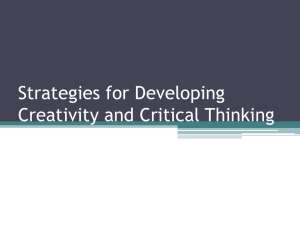Shannon Minton Final Essay June 27, 2011 CI 5310 Creativity Dr
advertisement

Shannon Minton Final Essay June 27, 2011 CI 5310 Creativity Dr. Susan Waite 2 Researchers and theorists have arrived at a consensus that creative thinking can be defined as being original and appropriate (Csikszentmihalyi & Wolfe, 2000; Georgsdottir, Lubart, & Getz, 2003; Smith, 2003; Paulus & Brown, 2003; Plucker & Beghetto, 2004; Starko, 2005; Sternberg, 2010; Fairweather & Cramond, 2010). According to Starko, there are different levels of creativity and described these as “’Creativity, with a big C’ that changes disciplines and ‘creativity with a little c,’ the more commonplace innovations of everyday life” (Starko, 2005). In addition, Starko claims that problem solving is at the base of “all types of creativity” (Starko, 2005). Therefore, divergent production is considered to be a vital component of the creative process (Baer & Garrett, 2010). Consequently, various models of creativity have emerged through the extensive research on creative thinking. One model of creativity was proposed by Wallas in 1926 and has four distinct stages: preparation, incubation, illumination, and verification (Georgsdottir, Lubart, & Getz, 2003; Starko, 2005). In the Wallas Model, the preparation stage involves gathering information, processing the problem, and deciding on a strategy to solve it. The incubation stage involves stepping away from the problem and doing something completely different in an effort for the brain to think about it subconsciously. The illumination stage is where the epiphany occurs or the “A-ha” moment happens. The verification stage is where the solution to the problem is validated and confirmed to be an appropriate solution. Another model of creativity was proposed by Mihaly Csikszentmihalyi called the Systems Model of Creativity (Csikszentmihalyi & Wolfe, 2000). In this model, there are three major components: domain, field, and person. The domain is considered to be any and all existing knowledge; the person is the individual or group of people with a creative idea. The field is considered to be the group of individuals who must weigh the originality and appropriateness of the creative idea to be accepted as new information into the domain. Sternberg posed the following: “Why is creativity even important? It is important because the world is changing at a far greater pace than it ever has before, and people need constantly to cope with 3 novel kinds of tasks and situations” (Sternberg, 2010). Given current research and theory on creativity, several factors can enhance creative thinking and creative production. One method includes brainstorming. Baer and Garrett state that four rules should be followed during brainstorming: “defer judgment, avoid ownership of ideas, feel free to ‘hitchhike’ on other ideas, and wild ideas are encouraged” (Baer & Garrett, 2010). These rules allow for high fluency of ideas, the flexibility to “think outside the box”, the opportunity to elaborate on other’s ideas, and to strive for originality in the creative thinking and divergent production (Georgsdottir, Lubart, & Getz, 2003; Paulus & Brown, 2003; Plucker & Beghetto, 2004; Baer & Garrett, 2010; Fairweather & Cramond, 2010). Another factor that enhances creative thinking is the notion of incubation. Theorists and researchers have observed that when individuals step away from a problem or situation and do something unrelated, it allows the brain to subconsciously work on the problem weighing different aspects of a potential solution (Smith, 2003; Paulus & Brown, 2003; Starko, 2005). Rituals have the potential to enhance the creative process as it allows the individual to free the mind of distractions by “getting into the zone” or achieving flow of creativity (Csikszentmihalyi & Wolfe, 2000; Tharp, 2003). Dissent has the potential to be beneficial to the creative process when the minority disagrees with the majority and a consensus cannot be reached. This opens the door to consider ideas that may be less popular nonetheless worth considering (Nemeth & Nemeth-Brown, 2003). Failure seems to be an oxymoron when it is associated with the creativity process; however, it is through failure of an idea that perpetuates the creativity of another idea that may be successful on the next attempt (Tharp, 2003; Lehrer, 2009). This course has been insightful in the information that was presented in addition to the method in which it was delivered. I found our daily divergent activities in this course to be fun, engaging, and liberating. Therefore, I have a new-found desire to incorporate divergent thinking activities in my high school math class to promote creativity and freedom to think outside the box in problem-solving. While I may not have used the term “incubation”, it is a strategy I often use personally and encourage my 4 students to do when they seem to be stuck in solving a problem. I am a firm believer that incubation is a valuable tool in creativity and in the problem-solving process. I have also learned that despite my lack of talent for being a creative or artistic drawer, I do possess a creative thought process and am inspired to discover a potentially deeper creative reserve within myself. Through this process, I hope to be a more creative individual who is willing to escape the comfort of my entrenched methods of instruction (Plucker & Beghetto, 2004). In response to Sternberg’s thoughts on the necessity of creativity, it is of utmost importance to inspire students to be creative in a day and age where technology is making exponential strides (Sternberg, 2010). Students need to be offered creative opportunities in the classroom by allowing them to brainstorm ideas fluently and flexibly. Students should be encouraged to incubate when they have reached a wall in their problem-solving process. Students should be inspired by their failures to continue their efforts not to fall victim to the failure itself. Students should consider all potential ideas to problem-solving even if they seem wild and silly or if they go against the popular vote. If teachers foster this type of atmosphere in the classroom – the little ‘c’, then today’s students will be tomorrow’s inventors, creators, and problem-solvers (Starko, 2005). 5 References Baer, J., & Garrett, T. (2010). Teaching for creativity in an era of content standards and accountability. In R.A. Beghetto & J.C. Kaufman (Eds.), Nurturing creativity in the classroom (pp. 6-23). New York: Cambridge University Press. Csikszentmihalyi, M., & Wolfe, R. (2000). New conceptions and research approaches to creativity: Implications of a systems perspective for creativity in education. In K. A. Heller, F. J. Monks, R. J. Sternberg, & R. F. Subotnik, (Eds.), International handbook of giftedness and talent (2nd ed.) (pp. 81-94). New York: Elsevier. Fairweather, E., & Cramond, B. (2010). Infusing creative and critical thinking into the curriculum together. In R.A. Beghetto & J.C. Kaufman (Eds.), Nurturing creativity in the classroom (pp. 113141). New York: Cambridge University Press. Georgsdottir, A. S., Lubart, T. I., & Getz, I. (2003). The role of flexibility in innovation. In L. V. Shavinina (Ed.), The international handbook of innovation (pp. 180-190). New York: Elsevier Science. Lehrer, J. (2009, December 21). Accept defeat: The neuroscience of screwing up. Wired. Retrieved from http://www.wired.com/magazine/2009/12/fail_accept_defeat/. Nemeth, C. J., & Nemeth-Brown, B. (2003). Better than individuals? The potential benefits of dissent and diversity for group creativity. In P. B. Paulus & B. A. Nijstad (Eds.), Group creativity (pp. 63-84). New York: Oxford University Press. Paulus, P. B., & Brown, V. R. (2003). Enhancing ideational creativity in groups: Lessons from research on brainstorming. In P. B. Paulus & B. A. Nijstad (Eds.), Group creativity (pp. 110-136). New York: Oxford University Press. Plucker, J. A., & Beghetto, R. A. (2004). Why creativity is domain general, why it looks domain specific, and why the distinction does not matter. In R. J. Sternberg, E. L. Grigorenko, & J. L. Singer (Eds.), Creativity: From potential to realization (pp. 153-168). Washington, D.C: American Psychological Association. Smith, S. M. (2003). The constraining effect of initial ideas. In P. B. Paulus & B. A. Nijstad (Eds.), Group creativity (pp. 15-31). New York: Oxford University Press. Sternberg, R.J. (2010). Teaching for creativity. In R.A. Beghetto & J.C. Kaufman (Eds.), Nurturing creativity in the classroom (pp.394-414). New York: Cambridge University Press. Starko, A. J. (2005). Creativity in the classroom: Schools of curious delight. Mahwah, NJ: Lawrence Erlbaum Associates. Tharp, T. (2003). The creative habit: Learn it and use it for life. New York: Simon & Schuster.





